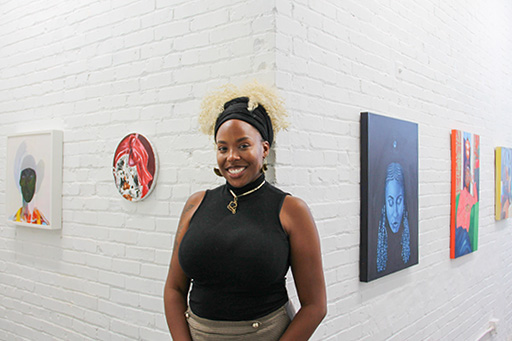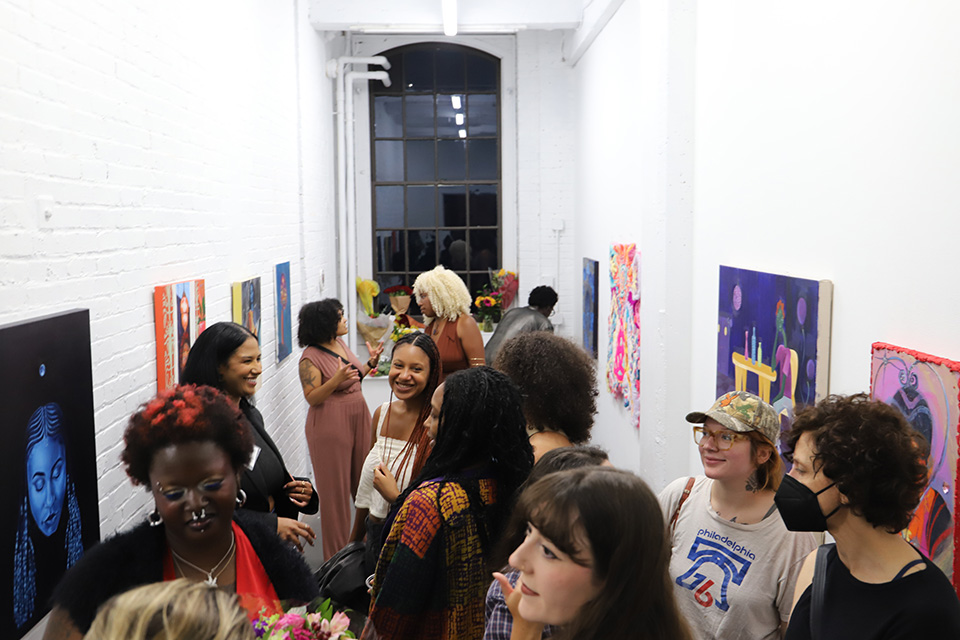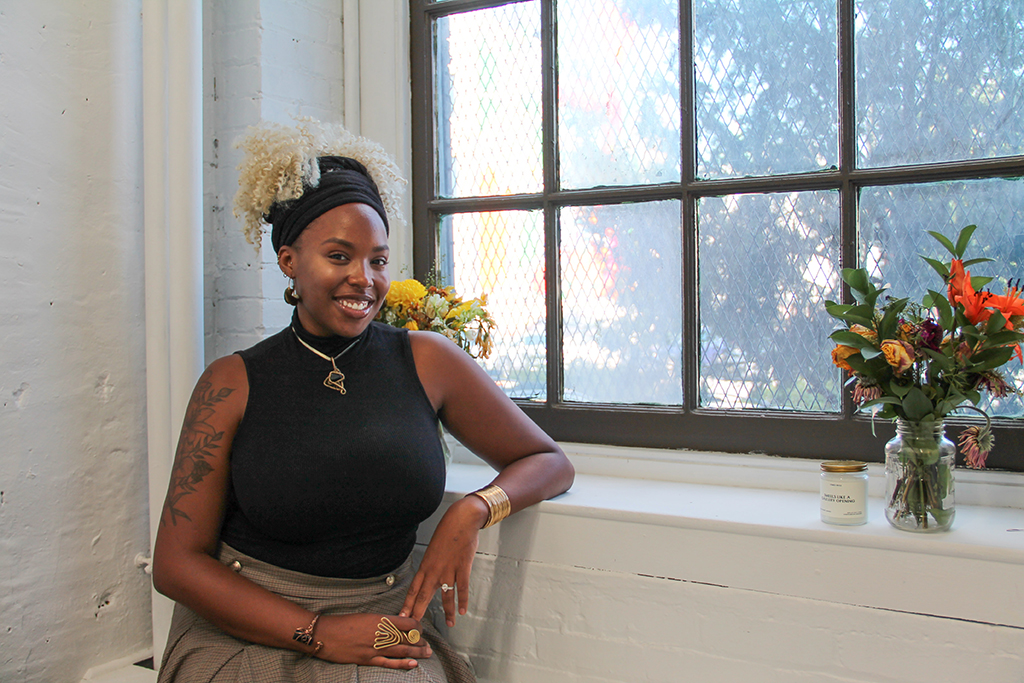In just 52 days, Tyler School of Art and Architecture alum Chelsey Luster (BFA ’19) transformed an empty space on the first floor of Crane Arts into a vibrant new gallery — one centered on supporting artists of color, women, and queer artists through exhibitions and collaborative programming.
Luster Gallery + Studio hosted the opening reception for its inaugural exhibition, “Shades: Expanding the Language of Black Skin,” on Sept. 11, marking a new chapter in Luster’s ongoing effort to make the art world more inclusive and accessible. As a painter, curator and arts advocate, Luster has built a career creating opportunities for others while sustaining her own creative practice—a balance she first began to cultivate as a student at Tyler.
The opportunity to open her own gallery came together quickly and almost by chance. A year earlier, Luster received a $15,000 Transformation Grant from the Leeway Foundation, which gave her the confidence to take the leap.
A Fast Start
Luster, who also works as the exhibition manager at Philadelphia’s Magic Gardens, began exploring the possibility of opening her own exhibition space earlier this spring. At Magic Gardens, she oversees exhibitions, manages an international artist residency and cares for thousands of works by mosaic artist Isaiah Zagar. That role, she said, has strengthened her understanding of what it takes to build and sustain creative institutions.
 “I always knew if I was to open a gallery or studio space in Philadelphia, I would want it to be in Crane Arts. I wanted to be surrounded by other artists and organizations so I can collaborate and work closely with this community,” Luster said.
“I always knew if I was to open a gallery or studio space in Philadelphia, I would want it to be in Crane Arts. I wanted to be surrounded by other artists and organizations so I can collaborate and work closely with this community,” Luster said.
She was drawn to Crane Arts not only for its location but for its collaborative, experimental energy. “Every gallery here collaborates with someone at some point. You can really feel the sense of community,” she said.
In July, she was contacted by the Crane Arts property manager, who explained that a vacant gallery space would be available in September. From there, it was a mad dash to prepare for her first gallery opening.
“I hit the ground running to launch a business and do everything else that came along with that in basically two months, from figuring out what the show was going to be, finding artists, picking up the work, and preparing the space,” she said.
She didn’t tell many people at first — not out of secrecy, but focus. “I just did it,” she said. “I had the experience, I had my LLC, and I just figured it out.”
Finding Direction at Tyler
Luster always knew she wanted to study art, but she also wanted a university that would expose her to a range of disciplines. Tyler School of Art and Architecture offered both.
“Tyler was a perfect fit because it’s at Temple University, where you can really study anything, but it’s also one of the best art programs in the country,” she said.
During her sophomore year, Luster began thinking seriously about what career path to pursue with a degree in painting. Her interest in curatorial work and arts programming was sparked through a galleries and museums course she took while studying abroad at Temple Rome.
“I could really see myself in those different roles, managing museum and gallery spaces, spending my days dealing with artists and helping them create their vision. I pretty much knew after that class what I wanted to do next,” she said.
When she returned to the United States, Luster pursued internships to gain firsthand experience. A show she installed as a senior in the Stella Elkins Gallery provided her with crucial portfolio material, helping her secure opportunities at artist-run and experiemental spaces such as Vox Populi and Icebox Project Space after graduation.
An Artist’s Approach to Curation
Luster views her role as curator as an inherently collaborative process, deeply informed by her own artistic practice. Her experience as both a practicing artist and a curator shapes the way she works with others: she meets artists where they are, offering encouragement, guidance and advocacy.
Luster often works with emerging and underrepresented artists, helping them rebuild confidence that may have been eroded by past experiences in formal art settings. Whether she’s offering support in a studio visit or advocating for clearer contracts and fair pay, she leads with empathy and transparency. 
“Sometimes when I walk into a studio visit, I’m encouraging artists to experiment with materials or have bigger conversations about their self-doubts and how to push through,” she said. “I feel like they’re comfortable talking to me on that level because they know I’m also making art. There’s definitely an artist relationship that comes first, before I step back as a curator.”
Part of what motivated Luster to open her own gallery was the desire to create the kind of professional, caring environment she didn’t always find elsewhere. “I’ve had collaborations where I didn’t feel respected, and I never want the artists I work with to feel that way,” she said. “Here, I can make sure they’re safe, supported and valued.”
A Philosophy of Abundance
Luster’s collaborative philosophy extends beyond her own gallery walls. She resists the competitive mindset often associated with the commercial art world, favoring teamwork and generosity instead. For her, other galleries and curators aren’t rivals but potential partners in expanding opportunities and resources for artists.
“There’s enough for everyone,” she said, emphasizing that abundance, not scarcity, drives her practice. From personally transporting artworks to ensuring artists are treated with respect and dignity, Luster is focused on exploring what professional care looks like in curatorial practice.
She plans to mount new exhibitions every two months, including open calls and group shows that highlight artists at different stages of their careers. Her long-term goal is to maintain a commercial model that still reflects her values of accessibility and equity. That means curating exhibitions with a wide range of price points and media so that anyone — from seasoned collectors to first-time art buyers — can find something meaningful to take home.
To current Tyler students, Luster offers simple but lasting advice: talk to curators and professionals whose work you admire, build relationships with your peers and don’t be afraid to ask for help. “You can’t do everything alone,” she said. “The art world works best when we collaborate.”

